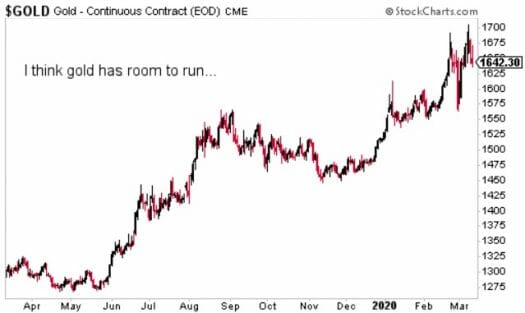It’s Time For Gold To Shine…
And just like that, more than $7 trillion in global equity market value has disappeared.
To call last week’s selloff epic is a bit of an understatement. Historic is more fitting. In just five days, the Dow Jones retreated by more than 3,500 points. In percentage terms, that’s a steep decline of 12%, which officially meets the technical definition of a correction.
And so far, the selloff has only intensified further this week.

Generally, it takes weeks or even months for a market correction to unfold. This one struck suddenly and without warning, the fastest in recorded history.
It was just as brutal for the tech-heavy Nasdaq and small-cap Russell 2000. Last week, the major averages all suffered their worst week since October 2008, the midst of the financial crisis.
This is a different kind of crisis altogether. The blame for this unrelenting selling can be pinned squarely on the coronavirus. For months, investors cast a wary eye on the infectious disease, but kept their cool and didn’t panic.
What has changed? Perhaps news from concerned health agencies that the number of new cases outside China has eclipsed those inside China for the first time. Translation: efforts to contain the virus have failed. As of this writing, the Covid-19 outbreak has spread to 122 countries, infecting more than 124,000 and killing more than 4,500.
Those numbers seem to climb by the hour.
What This Means For The Market
Needless to say, restricting the movement of goods and people isn’t exactly conducive to commerce. And we’re starting to see the economic fallout. One closely watched Chinese manufacturing gauge just blared the lowest reading in 16 years. Another report suggests the toll on the airline industry could exceed $100 billion this year.
From supply chain disruptions to canceled exports, the damage that was once confined to the travel industry has spilled over into the broader markets. Shippers, retailers, oil producers… just about everyone is in the path of the storm.
Across the developed world, the OECD has just revised its 2020 economic growth forecast from 2.9% down to 2.4%. But Chief Economist Laurence Boon concedes that this is a best-case scenario.
The global economy was already in a fragile state, weakened by tariffs and trade disputes. If containment measures don’t hold and the dam is breached, then all bets are off. No less an authority than Janet Yellen, former Chief of the Federal Reserve, has said that recession is a real possibility.
For its part, Goldman Sachs is warning that S&P earnings growth may completely flatline in 2020. Even alcohol is a tough sell right now. Anheuser-Busch (NYSE: BUD) just forecast the steepest quarterly earnings decline in a decade.
I believe this is just the beginning of a wave of negative pre-announcements. Even for businesses not directly affected, it’s a ready-made excuse.
Fortunately, consumer confidence is holding for now. But this contagion hasn’t run its course just yet; new cases outside China are still multiplying. And one quick glance at the 10-Year Treasury chart shows that anxiety is running high – yields just recently hit a new record low.

But it’s a great time to be holding one thing: gold. The greater the panic, the more investors clamor for the yellow metal. And they have been in a stampede in recent weeks, driving prices to a seven-year peak above $1,650 per ounce. A year ago, gold was closer to $1,300.

Should you be looking at precious metals? In a word, yes. But not just because of the coronavirus…
Geopolitics. Coronavirus. Recession. Take your pick of these wildcards. The more fears intensify, the greater the appetite for gold. Keep in mind, the metal is also an insurance policy against currency devaluation and inflation. It also tends to perform better ahead of falling interest rate environments. Already, investors are turning to the world’s central banks for stimulative rate cuts to prop up the global economy. And we just got an emergency half-point cut from the Fed.
Action To Take
Bottom line, I don’t think this rally has run its course. Gold has always been a hedge against market volatility and a reliable store of value during times of macroeconomic distress. For perspective, the last time we saw a market rout like this in October 2008, gold eventually sprinted as high as $1,900 per ounce.
That’s a predictable pattern. According to State Street, gold has provided an average return of 6.3% during the last 14 equity market downturns, while the S&P lost -21.5%.
And this time, we’ve got more exchange-traded funds such as SPDR Gold Trust (NYSE: GLD) hoarding physical supplies.
On that note, GLD isn’t a bad option for investors right now. But stay tuned, because I plan to delve deeper into gold soon, with a few suggestions for even better ways to profit.
In the meantime, I want you to set a reminder for 1 p.m. (ET) today. Because if you’re looking for money-making advice that can weather any storm, then you need to tune in to our free event with master trader Jim Fink.
As some of you know, Jim has perfected a trading system that reaps profits in up or down markets… even when the markets are a roller coaster like they’ve been here lately. In this live seminar, Jim will explain how his scientific investing system pinpoints stock movements as small as 1%, before they happen, and then leverages those movements for whopping gains.
We’re not charging a single penny for this event. That’s because we think it could easily be the most important tool to help you navigate the chaotic market we’re seeing today and come out ahead. In fact, Jim already has used his system to deliver 20,747% profits to a small group of readers in less than five years.
Again, I encourage you to secure your place on this special event. But spots are limited and they’re going fast. Click here to guarantee your spot.
